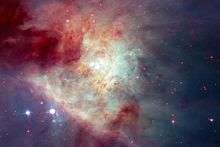Kleinmann–Low Nebula
The Kleinmann–Low Nebula (also known as the Orion KL Nebula) is an active star forming region in the Milky Way galaxy. It is a cluster of stars within a molecular cloud.[3][4]
| Nebula | |
|---|---|
 | |
| Observation data: J2000 epoch | |
| Right ascension | 05h 35m 14.16s[2] |
| Declination | −05° 22′ 21.5″[2] |
| Constellation | Orion |
The Kleinmann–Low Nebula is the at the heart of the Orion Nebula, and is the most active star-forming region in it. Because of the thick dust surrounding it, it is observed primarily with infrared light, since visible light cannot pass through it.[3] Hot stellar winds circulate off large, young, stars in Orion’s nebula and heat the surrounding gas. This then causes an explosion that has a cityscape obtrusion look.[3] It is named after Douglas Kleinmann and Frank J. Low, who discovered the nebula in 1967.[5]Between 1972 and 1973 a large amount of maps were secured with the Steward and Catalina Observatories telescopes.[6]
The luminosity of the Kleinmann-Low Nebula is approximately 3.828x10^31 Watts, or roughly 10^5 times that of the sun with, making the nebula the brightest component of the OMC-1 Complex. The dust surrounding the Kleinmann-Low Nebula calculated to be approximately 70K. The nebula is estimated to be rather cool at less than 600 Kelvin, yet it is viewed at less than 20 microns to be extremely active based on the infrared light it gives off. Inside of the nebula, the brightest object observed is the Becklin-Neugebauer Object.[5]
The Kleinmann-Low nebula is rich in the molecules HCOOCH3, CH3OCH3 and deuterated methanol, and abundant with nascent stars and planetary systems.[7]
References
- "New Hubble mosaic of the Orion Nebula – Hunting for rogue planets and runaway stars". www.spacetelescope.org. Retrieved 17 March 2017.
- "NAME Orion-KL". SIMBAD. Centre de données astronomiques de Strasbourg. Retrieved 30 July 2017.
- Nemiroff, R.; Bonnell, J., eds. (2 March 1999). "The Kleinmann–Low Nebula". Astronomy Picture of the Day. NASA.
- Ferland pp191
- David Darling. "Kleinmann–Low Nebula". The Internet Encyclopedia of Science. Retrieved 30 July 2017.
- "1973ApJ...186L...7R Page L7". adsabs.harvard.edu. Retrieved 2019-04-01.
- Guélin, M.; Wlodarczak, G.; Combes, F.; Favre, C.; Baudry, A.; Peng, T.-C.; Brouillet, N.; Despois, D. (2014). "Complex molecules in the Orion Kleinmann-Low nebula". BIO Web of Conferences. 2: 03006. doi:10.1051/bioconf/20140203006. ISSN 2117-4458.
Bibliography
- Ferland G. J. Osterbrock Donald E. (2005) Astrophysics of gaseous nebulae and active galactic nuclei University Science Books ISBN 978-1-891389-34-4